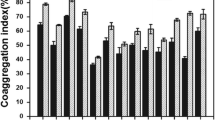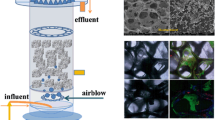Abstract
Degradation of nitriles by mixed biofilms of nitrile-hydrolyzing bacteria Alcaligenes faecalis 2 and Rhodococcus ruber gt 1 grown on basalt and carbon carriers, in a submerged packed-bed reactor was studied. It was shown the formation of a massive mixed biofilm of Al. faecalis 2 and R. ruber gt 1 and the effective removal of nitriles and products of their degradation from the reaction medium. After the accumulation of carboxylic acid and some of the unprocessed substrate, the system adapts to 600–1000 h of biofilter operation, which is expressed in a decrease in the content of substrate and reaction products in the medium. The rate of acetonitrile and acrylonitrile utilization was 0.072–0.086 and 0.039–0.215 g/h, respectively, and acrylonitrile utilization with maximum rate was realized by a mixed biofilm on carbon fibers. Biofilms grown on mixed fibers in a "sandwich"-type reactor had the best characteristics for the transformation of aceto- and acrylonitrile (removal capacity of 99.6–99.9%, nitrile utilization rate of 0.080–0.095 g/h). Biofilms grown on basalt fiber with a diameter of 4–12 μm are also well suited for the degradation of acetonitrile (removal capacity of 100%, nitrile utilization rate of 0.086 g/h). The results of metagenomic analysis showed the resistance of Al. faecalis 2 and R. ruber gt 1 mixed biofilms against leaching from a biofilter and to competitive growth in an open system, indicating the advantages of biofilms over homogeneous biomass for wastewater treatment from nitrile compounds. Biofilms of two species of nitrile hydrolyzing bacteria on basalt and carbon fibers effectively purify water from nitriles in a submerged packed-bed reactor.





Similar content being viewed by others
References
Debabov VG, Yanenko AS (2011) Biocatalytic hydrolysis of nitriles. Obz Zh Khim 1(4):376–394. https://doi.org/10.1134/S2079978011030010
Achanzar WE, Mangipudy RS (2014) Acrylonitrile. In: Wexler P (ed) Encyclopedia of toxicology, 3rd edn. Academic Press, London, pp 76–78
Caito S, Costa LG, Rongzhu L, Aschner M (2014) Acrylonitrile. In: Aminoff MJ, Daroff RB (eds) Encyclopedia of the neurological sciences, 2nd edn. Academic Press, London, pp 33–35
Liu Q, Fang B, Bai X, Liu Y, Wu Y, Xu G, Guo C (2016) Direct synthesis of nitriles from cleavage of C=C double bond with nitrite as the nitrogen source and oxidant. Tetrahedron lett 57(24):2620–2623. https://doi.org/10.1016/j.tetlet.2016.04.108
Robles H (2014) Acetonitrile. In: Wexler P (ed) Encyclopedia of toxicology, 3rd edn. Academic Press, London, pp 40–42
Zhai Y, St-Pierre J (2019) Acetonitrile contamination in the cathode of proton exchange membrane fuel cells and cell performance recovery. Appl Energy 242:239–247. https://doi.org/10.1016/j.apenergy.2019.03.086
Zhan W, Tong M, Ji L, Zhang H, Ge Z, Wang X, Li R (2019) Continuous-flow synthesis of nitriles from aldehydes via Schmidt reaction. Chinese Chem Lett 30(5):973–976. https://doi.org/10.1016/j.cclet.2019.01.006
Zheng L, Pan L, Miao J, Lin Y, Wu J (2018) Application of a series of biomarkers in Scallop Chlamys farreri to assess the toxic effects after exposure to a priority hazardous and noxious substance (HNS) – Acrylonitrile. Environ Toxicol Pharm 64:122–130. https://doi.org/10.1016/j.etap.2018.10.002
Gupta N, Balomajumber Ch, Agarwal VK (2010) Enzymatic mechanism and biochemistry for cyanide degradation: a review. J Hazard Mater 176:1–13. https://doi.org/10.1016/j.jhazmat.2009.11.038
Prasad S, Bhalla TC (2010) Nitrile hydratases (NHases): At the interface of academia and industry. Biotechnol Adv 28:725–741. https://doi.org/10.1016/j.biotechadv.2010.05.020
Kohyama E, Yoshimura A, Aoshima D, Yoshida T, Kawamoto H, Nagasawa T (2006) Convenient treatment of acetonitrile-containing wastes using the tandem combination of nitrile hydratase and amidase-producing microorganisms. Appl Microbiol Biotechnol 72:600–606. https://doi.org/10.1007/s00253-005-0298-x
Kohyama E, Dohi M, Yoshimura A, Yoshida T, Nagasawa T (2007) Remaining acetamide in acetonitrile degradation using nitrile hydratase- and amidase-producing microorganisms. Appl Microbiol Biotechnol 74:829–835. https://doi.org/10.1007/s00253-006-0738-2
Chen CY, Chen SC, Fingas M, Kao CM (2010) Biodegradation of propionitrile by Klebsiella oxytoca immobilized in alginate and cellulose triacetate gel. J Hazard Mater 177:856–863. https://doi.org/10.1016/j.jhazmat.2009.12.112
Li C, Sun Y, Yue Z, Huang M, Wang J, Chen X, An X, Zang H, Li D, Hou N (2018) Combination of a recombinant bacterium with organonitrile-degrading and biofilm-forming capability and a positively charged carrier for organonitriles removal. J Hazard Mater 353:372–380. https://doi.org/10.1016/j.jhazmat.2018.03.058
An X, Cheng Y, Huang M, Sun Y, Wang H, Chen X, Wang J, Li D, Li C (2018) Treating organic cyanide-containing groundwater by immobilization of a nitrile-degrading bacterium with a biofilm-forming bacterium using fluidized bed reactors. Environ Pollut 237:908–916. https://doi.org/10.1016/j.envpol.2018.01.087
Li T, Bai R, Ohandja D-G, Liu J (2009) Biodegradation of acetonitrile by adapted biofilm in a membrane-aerated biofilm reactor. Biodegradation 20(4):569–580. https://doi.org/10.1007/s10532-008-9246-7
Demakov VA, Vasil’ev DM, Maksimova YG, Pavlova YA, Ovechkina GV, Maksimov AY (2015) Activated sludge bacteria transforming cyanopyridines and amides of pyridinecarboxylic acids. Microbiol 84:433–441. https://doi.org/10.1134/S0026261715030030
Maksimov AY, Kuznetsova MV, Ovechkina GV, Kozlov SV, Maksimova YG, Demakov VA (2003) Effects of nitriles and amides on the growth and nitrile hydratase activity of the Rhodococcus sp. strain gt1. Appl Biochem Microbiol 39(1):55–59. https://doi.org/10.1023/A:1021798010261
Zorina AS, Maksimova YG, Demakov VA (2019) Biofilm formation by monocultures and mixed cultures of Alcaligenes faecalis 2 and Rhodococcus ruber gt 1. Microbiol 88(2):164–171. https://doi.org/10.1134/S0026261719020140
Maksimova YG, Vasil’ev DM, Zorina AS, Ovechkina GV, Maksimov AY (2018) Acrylamide and acrylic acid biodegradation by Alcaligenes faecalis 2 planktonic cells and biofilms. Appl Biochem Microbiol 54(2):173–178. https://doi.org/10.1134/S0003683818020084
Manolov T, Håkansson K, Benoit G (2005) Continuous acetonitrile degradation in a packed-bed bioreactor. Appl Microbiol Biotechnol 66:567–574. https://doi.org/10.1007/s00253-004-1744-x
Li C, Yue Z, Feng F, Xi C, Zang H, An X, Liu K (2016) A novel strategy for acetonitrile wastewater treatment by using a recombinant bacterium with biofilm-forming and nitrile-degrading capability. Chemosphere 161:224–232. https://doi.org/10.1016/j.chemosphere.2016.07.019
Dash RR, Gaur A, Balomajumder C (2009) Cyanide in industrial wastewaters and its removal: a review on biotreatment. J Hazard Mater 163:1–11. https://doi.org/10.1016/j.jhazmat.2008.06.051
An X, Cheng Y, Miao L, Chen X, Zang H, Li C (2020) Characterization and genome functional analysis of an efficient nitrile-degrading bacterium, Rhodococcus rhodochrous BX2, to lay the foundation for potential bioaugmentation for remediation of nitrile-contaminated environments. J Hazard Mater 389:121906. https://doi.org/10.1016/j.jhazmat.2019.121906
Alvillo-Rivera A, Garrido-Hoyos S, Buitrón G, Thangarasu-Sarasvathi P, Rosano-Ortega G (2021) Biological treatment for the degradation of cyanide: a review. J Mater Res Technol 12:1418–1433. https://doi.org/10.1016/j.jmrt.2021.03.030
Acknowledgements
The work was carried out within the framework of the state assignment on the topic " Search and selection of new promising microorganisms for the purposes of biotechnology. Creation of immunochemical diagnostic systems ", registration number R&D 122010800029-1.
Author information
Authors and Affiliations
Corresponding author
Additional information
Publisher's Note
Springer Nature remains neutral with regard to jurisdictional claims in published maps and institutional affiliations.
Supplementary Information
Below is the link to the electronic supplementary material.
Rights and permissions
About this article
Cite this article
Zorina, A.S., Maksimov, A.Y. & Maksimova, Y.G. Degradation of Nitriles by Mixed Biofilms of Nitrile-Hydrolyzing Bacteria in Submerged Packed-Bed Reactor. Indian J Microbiol 62, 610–617 (2022). https://doi.org/10.1007/s12088-022-01030-z
Received:
Accepted:
Published:
Issue Date:
DOI: https://doi.org/10.1007/s12088-022-01030-z




